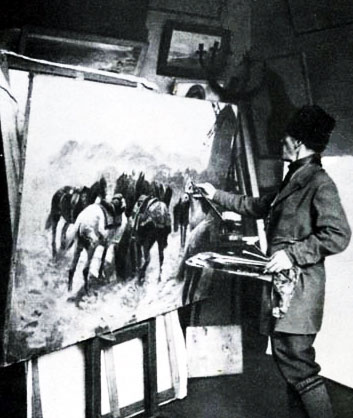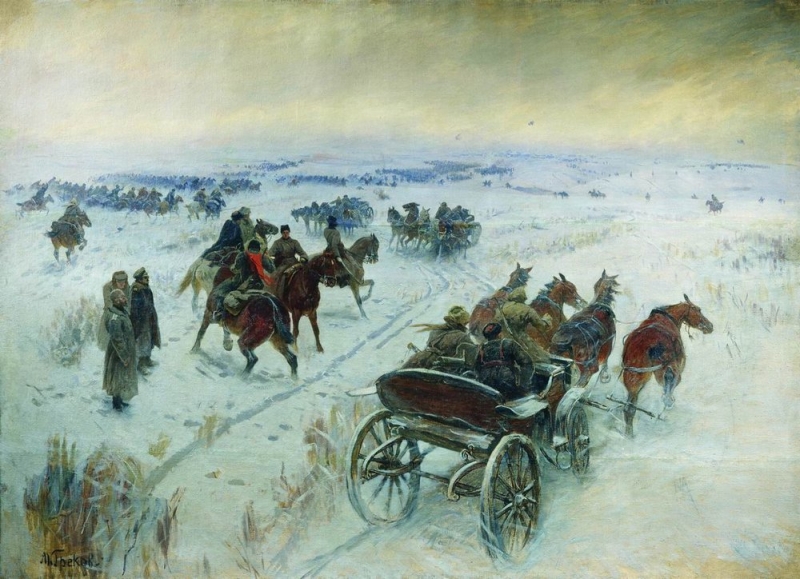|
Mitrofan Grekov
Mitrofan Borisovich Grekov (Russian: Митрофан Борисович Греков; born: Mitrofan Pavlovich Martyshchenko; 15 June Old_Style_and_New_Style_dates.html" ;"title="nowiki/>Old Style and New Style dates">O. S. 3 June 1882 – November 27, 1934) was a Russian and Soviet painter, considered to be the "father of Soviet battle painting". Biography Born in a Cossack family, at the age of 15, he went to study painting, first at the Odessa Art School (with Kiriyak Kostandi), then 5 years later, after successfully passing the exams, he ended up at the St. Petersburg Academy of Arts, where he studied with Ilya Repin">Imperial Academy of Arts">St. Petersburg Academy of Arts, where he studied with Ilya Repin and Franz Roubaud. During his studies, he worked on Roubaud's panoramas "Defense of Sevastopol" and "Battle of Borodino". In 1911, for the competitive work "Oxen in the Plow" he was awarded the title of artist. From 1912 he served in the Life Guards Ataman Regiment. D ... [...More Info...] [...Related Items...] OR: [Wikipedia] [Google] [Baidu] |
Don Host Oblast
The Province (Oblast) of the Don Cossack Host (, ''Oblast’ Voyska Donskogo'') of Imperial Russia was the official name of the territory of Don Cossacks, coinciding approximately with the present-day Rostov Oblast of Russia. Its site of administration was Cherkassk, relocated later to Novocherkassk. The province comprised the areas where the Don Cossack Host settled in the Russian Empire. From 1786 the territory was officially named the Lands of the Host of the Don (), renamed Don Host Province in 1870. During 1913, the oblast, with an area of about 165,000 km², had about 3.8 million inhabitants. Of these, 55% (2.1 million) were Cossacks in possession of all the land; the remaining 45% of the population being townsfolk and agricultural guest labourers from other parts of Russia. This subdivision was abolished in 1920; from the major part of it the Don Oblast of the Russian Socialist Federative Soviet Republic, RSFSR was created, which was incorporated into the North Cau ... [...More Info...] [...Related Items...] OR: [Wikipedia] [Google] [Baidu] |
Association Of Artists Of Revolutionary Russia
The Association of Artists of Revolutionary Russia (russian: Ассоциация художников революционной России, ''Assotsiatsia Khudozhnikov Revolutsionnoi Rossii'', 1922–1928), later known as Association of Artists of the Revolution (Ассоциация художников революции, ''Assotsiatsia Khudozhnikov Revolutsii'' or AKhRR, 1928–1932) was a group of artists in the Soviet Union in 1922–1933. Diverse members of the group gained favor as the legitimate bearers of the Communist ideas into the world of art, formulating framework for the socialist realism style. It was a large association of Soviet artists, graphic artists and sculptors, which, thanks to the support of the state, was the largest and most powerful of the creative groups of the 1920s. Founded in 1922, AKhRR was active for about 10 years before it disbanded in 1932. During this time it was the forerunner of the united Artists' Union of the USSR. Original founding me ... [...More Info...] [...Related Items...] OR: [Wikipedia] [Google] [Baidu] |
Repin Institute Of Arts Alumni
Repin (russian: Ре́пин; masculine) or Repina (; feminine) is a Russian last name. It is derived from the sobriquet ''"репа"'' ("turnip") and may refer to the following people: *Ilya Repin (1844–1930), Ukrainian and Russian painter * Nikolay Repin (b. 1932), Soviet painter *Vadim Repin (b. 1971), Russian violinist Archaeology *The Repin culture, the first phase (or, depending on the author, the forerunner) of the Pit Grave/Ochre Grave/Yamnaya culture. Other uses * Řepín, a village and municipality of the Czech Republic. * 2468 Repin, a Main-belt Asteroid named after Ilya Repin. See also *Repino Repino (russian: Репино) is the name of several inhabited localities in Russia. Modern localities ;Urban localities * Repino, Saint Petersburg, a municipal settlement in Kurortny District of the federal city of St. Petersburg ;Rural ..., several inhabited localities in Russia {{Disambiguation, surname Russian-language surnames ... [...More Info...] [...Related Items...] OR: [Wikipedia] [Google] [Baidu] |
War Artists From The Russian Empire
War is an intense armed conflict between states, governments, societies, or paramilitary groups such as mercenaries, insurgents, and militias. It is generally characterized by extreme violence, destruction, and mortality, using regular or irregular military forces. Warfare refers to the common activities and characteristics of types of war, or of wars in general. Total war is warfare that is not restricted to purely legitimate military targets, and can result in massive civilian or other non-combatant suffering and casualties. While some war studies scholars consider war a universal and ancestral aspect of human nature, others argue it is a result of specific socio-cultural, economic or ecological circumstances. Etymology The English word ''war'' derives from the 11th-century Old English words ''wyrre'' and ''werre'', from Old French ''werre'' (also ''guerre'' as in modern French), in turn from the Frankish *''werra'', ultimately deriving from the Proto-Germanic *''we ... [...More Info...] [...Related Items...] OR: [Wikipedia] [Google] [Baidu] |
Soviet Painters
This is a list of Russians artists. In this context, the term "Russian" covers the Russian Federation, Soviet Union, Russian Empire, Tsardom of Russia and Grand Duchy of Moscow, including ethnic Russians and people of other ethnicities living in Russia. This list also includes those who were born in Russia but later emigrated, and those who were born elsewhere but immigrated to the country and/or worked there for a significant period of time. Alphabetical list __NOTOC__ A B C D E F G H I J K L M N O P R S T U V W Y Z See also * Russian Academy of Arts * List of 19th-century Russian painters * List of 20th-century Russian painters * List of Russian landscape painters * List of painters of Saint Petersburg Union of Artists * :Russian artists * List of Russian architects * List of Russian inventors * List of Russian explorers * List of Russian language writers * Russian culture {{Asian artists Artists * ... [...More Info...] [...Related Items...] OR: [Wikipedia] [Google] [Baidu] |
Painters From The Russian Empire
Painting is the practice of applying paint, pigment, color or other medium to a solid surface (called the "matrix" or "support"). The medium is commonly applied to the base with a brush, but other implements, such as knives, sponges, and airbrushes, can be used. In art, the term ''painting ''describes both the act and the result of the action (the final work is called "a painting"). The support for paintings includes such surfaces as walls, paper, canvas, wood, glass, lacquer, pottery, leaf, copper and concrete, and the painting may incorporate multiple other materials, including sand, clay, paper, plaster, gold leaf, and even whole objects. Painting is an important form in the visual arts, bringing in elements such as drawing, composition, gesture (as in gestural painting), narration (as in narrative art), and abstraction (as in abstract art). Paintings can be naturalistic and representational (as in still life and landscape painting), photographic, abstract, n ... [...More Info...] [...Related Items...] OR: [Wikipedia] [Google] [Baidu] |
1934 Deaths
Events January–February * January 1 – The International Telecommunication Union, a specialist agency of the League of Nations, is established. * January 15 – The 8.0 1934 Nepal–Bihar earthquake, Nepal–Bihar earthquake strikes Nepal and Bihar with a maximum Mercalli intensity scale, Mercalli intensity of XI (''Extreme''), killing an estimated 6,000–10,700 people. * January 26 – A 10-year German–Polish declaration of non-aggression is signed by Nazi Germany and the Second Polish Republic. * January 30 ** In Nazi Germany, the political power of federal states such as Prussia is substantially abolished, by the "Law on the Reconstruction of the Reich" (''Gesetz über den Neuaufbau des Reiches''). ** Franklin D. Roosevelt, President of the United States, signs the Gold Reserve Act: all gold held in the Federal Reserve is to be surrendered to the United States Department of the Treasury; immediately following, the President raises the statutory gold price from ... [...More Info...] [...Related Items...] OR: [Wikipedia] [Google] [Baidu] |
1882 Births
Year 188 (CLXXXVIII) was a leap year starting on Monday of the Julian calendar. At the time, it was known in the Roman Empire as the Year of the Consulship of Fuscianus and Silanus (or, less frequently, year 941 ''Ab urbe condita''). The denomination 188 for this year has been used since the early medieval period, when the Anno Domini calendar era became the prevalent method in Europe for naming years. Events By place Roman Empire * Publius Helvius Pertinax becomes pro-consul of Africa from 188 to 189. Japan * Queen Himiko (or Shingi Waō) begins her reign in Japan (until 248). Births * April 4 – Caracalla (or Antoninus), Roman emperor (d. 217) * Lu Ji (or Gongji), Chinese official and politician (d. 219) * Sun Shao, Chinese general of the Eastern Wu state (d. 241) Deaths * March 17 – Julian, pope and patriarch of Alexandria * Fa Zhen (or Gaoqing), Chinese scholar (b. AD 100) * Lucius Antistius Burrus, Roman politician (executed) * Ma Xiang, Chi ... [...More Info...] [...Related Items...] OR: [Wikipedia] [Google] [Baidu] |
Tretyakov Gallery
The State Tretyakov Gallery (russian: Государственная Третьяковская Галерея, ''Gosudarstvennaya Tretyâkovskaya Galereya''; abbreviated ГТГ, ''GTG'') is an art gallery in Moscow, Russia, which is considered the foremost depository of Russian fine art in the world. The gallery's history starts in 1856 when the Moscow merchant Pavel Mikhailovich Tretyakov acquired works by Russian artists of his day with the aim of creating a collection, which might later grow into a museum of national art. In 1892, Tretyakov presented his already famous collection of approximately 2,000 works (1,362 paintings, 526 drawings, and 9 sculptures) to the Russian nation. The museum attracted 894,374 (visitors in 2020 (down 68 percent from 2019), due to the COVID-19 pandemic. It was 13th on the list of most-visited art museums in the world in 2020. The façade of the gallery building was designed by the painter Viktor Vasnetsov in a peculiar Russian fairy-tale style. ... [...More Info...] [...Related Items...] OR: [Wikipedia] [Google] [Baidu] |
Artists' Union Of The USSR
The Artists' Union of the USSR (russian: Союз художников СССР, translit=Soyuz khudozhnikov SSSR) was a creative union of the Soviet artists and art critics embracing the Republics of the Soviet Union, Republics of the Soviet Union. The Union was founded started in 1932 to supersede the AKhRR. The integral Union was instituted in 1957. By January 1, 1976, the Union included 14,538 members. In was officially disbanded at its 8th Congress in January 1992 after the dissolution of the Soviet Union, with its rights distributed over the corresponding unions in the post-Soviet states. History Prior to the Artists' Union of the USSR, there existed the Union of Soviet Artists (Союз советских художников, ''Soyuz sovetskikh khudozhnikov''), which was founded by Alexander Grigoriev (Artist), Alexander Grigoriev in Moscow in spring 1930. It included Moscow and Leningrad artists along with former members of the AKhRR. The first exhibition of the Union of ... [...More Info...] [...Related Items...] OR: [Wikipedia] [Google] [Baidu] |
House-Museum Of Mitrofan Grekov
The House-Museum of Mitrofan Grekov ( rus, Дом-музей Митрофана Грекова, r=Dom-muzyey Mitrofana Grekova) opened in 1957 in Novocherkassk, Rostov oblast, Russia and is devoted to the exhibition of the Soviet battle painter's things, Sketch (drawing), sketches, as well as to the research and study of his creative output. It is an affiliate of the Museum of Don Cossacks. An historic building of the museum is considered to be an object of cultural heritage. History Battle painter Martyshchenko Mitrofan Pavlovich primarily known as Mitrofan Grekov was born in khutor of Sharpaevka, Don Host Oblast, Russian Empire on 3 June 1882. He graduated from Odessa art school and the Saint Petersburg Academy of Arts. Grekov is founder of Soviet battle genre. He spent in Novocherkassk 14 years of his life. Grekov lived here from June 1918 to 1931. At this period Grekov created 94 paintings include ''To the squadron with Budyonny'' (1923), ''Tachanka'' (1925), ''Mounted attack ... [...More Info...] [...Related Items...] OR: [Wikipedia] [Google] [Baidu] |








